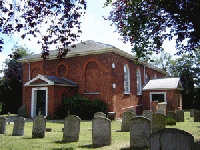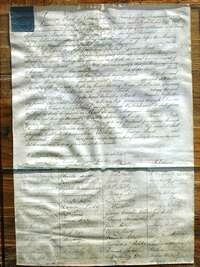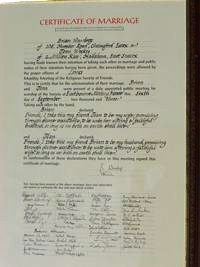History: Marriage, Birth, Death
Marriages
As in the rest of England, Mid-Essex Quakers rejection of the established church posed problems for marriage and burials.
In 1653, following a ruling from Parliament that made compulsory a civil marriage ceremony before a justice of the peace, Fox wrote "For the right joyning in marriage is the work of the Lord only, and not the priests or magistrates; for it is God's ordinance and not man's; and therefore Friends [Quakers] cannot consent that they should joyn them together; for we marry none, it's the Lord's work and we are but witnesses". Fox then established the basis of Quaker procedure, stressing the three principles of: adequate preliminaries (to examine prospective spouses concerning their intentions to marry, and to determine that there were no familial obstacles or other potential problems); an open ceremony (including an exchange of declarations and the signing of a certificate); and an efficient method of registration of the marriage. Once the local meeting had approved the couple's intention, an announcement would be made and posted in the market on market day. After this, the wedding could take place.
Following the restoration of the established church for legal marriage in 1660, the Quakers secured successive civil law judgements upholding their marriage as good in law, based largely on the marriage procedure and record keeping established by Fox. It was not until 1753 that Quaker marriages were implicitly recognised by the State, and only in the 1836 Marriage Act that Quaker marriages were explicitly recognised.
The form of the Quaker Marriage certificate has remained largely unaltered over the years, Above are two certificates held by Mid-Essex Quakers - one from 1828 for the marriage of George Wood, a Chelmsford ironmonger, and one from 2003. The declarations of the two couples are stated, and the certificate witnessed by those present at the marriage.
Births
Locally registers were kept from the late 1650s for births. Responsibility rested with the Monthly Meeting (now Area meeting) who received 'birth notes' from the Preparative Meetings (now Local Meetings), once registered one copy was sent to the Quarterly Meeting. Following the 1776 Yearly Meeting, printed books were provided for this. In some cases adult members recorded their own dates of birth, so that some of the earlier registers contain retrospective entries.
Chelmsford Quaker burial ground, Broomfield Road

Maldon Quaker Meeting House and burial ground
Burials
Burials also caused concern to early Quakers. All burials took place in the local churchyard and were carried out by the priest with the Church Burial Service. Quakers could not accept this, so they had to acquire their own burial ground, and often the burial ground was acquired before the building of the meeting house
Chelmsford Meeting has had several burial grounds as it has moved Meeting Houses. The first was in Baddow Road, and then in Duke Street, and the current burial ground, shown here, is off Broomfield Road. It was laid out in 1855, and contains headstones from the burial ground in Duke Street. There are magnificent cedar of Lebanon trees along Broomfield Road and in the burial ground, which have grown from seeds collected from the holy land by visiting Chelmsford Quakers.
Witham had a burial ground in Chipping Hill from 1692.
Maldon Meeting House has a burial ground, shown here.
In the archives at Chelmsford Meeting House there is a Register of Burials for the Duke Street site from 1825 to 1855, after which the new burial ground in Broomfield Road was used. The Register entries were made by John Candler of Springfield, who frequently added a commentary of his own (not always complimentary!). Here is one of the entries:
Entry 36
Joseph Wood of Springfield aged about 87 years. Died the 9th month 1832.This very aged man was once a farmer and occupied land in the parish of Sandon but retired from business when he grew an old man, and lived in a cottage with his wife and daughters on the scanty earnings of his past years, aided by the contributions of a generous friend.A very stout man, dressed in a suit of orthodox drab, with a three cornered looped hat, somewhat rusty from long wear, it was curious to see him mounted on a donkey, making his way slowly through the town to meeting. He was a very ignorant unreflecting man, having very few ideas, and passed his time as if the chief end of existence were to eat and drink, and to bask in the beams of the sun.His daughters nursed him faithfully in sickness and he died full of years.


